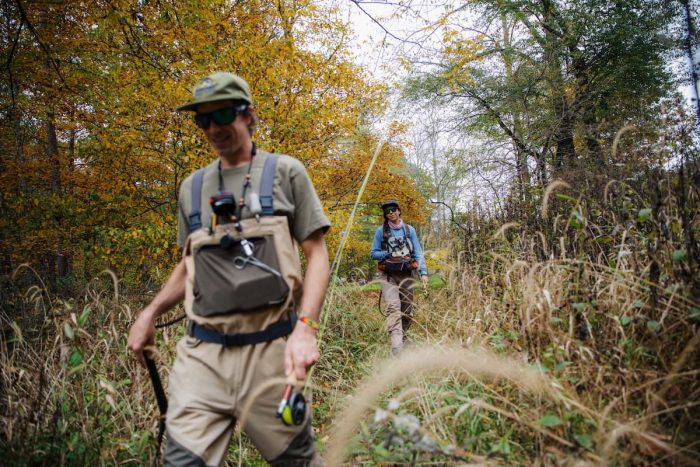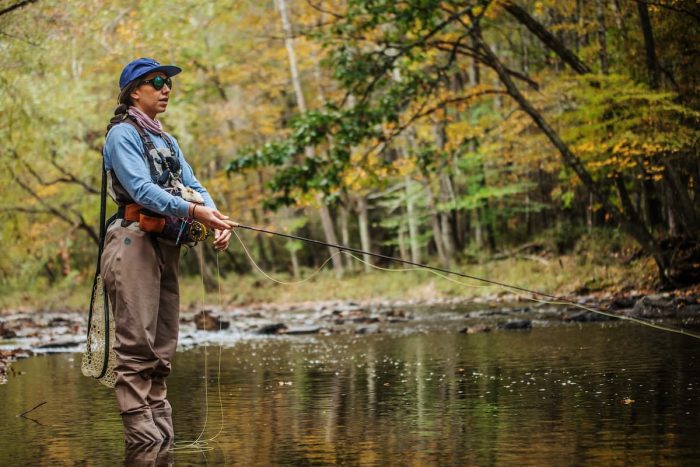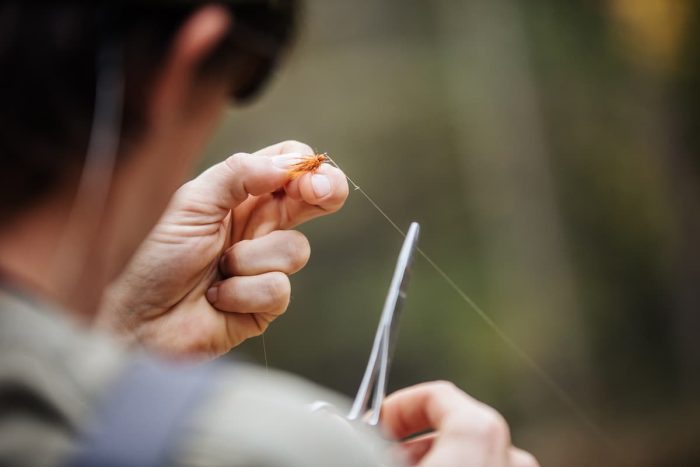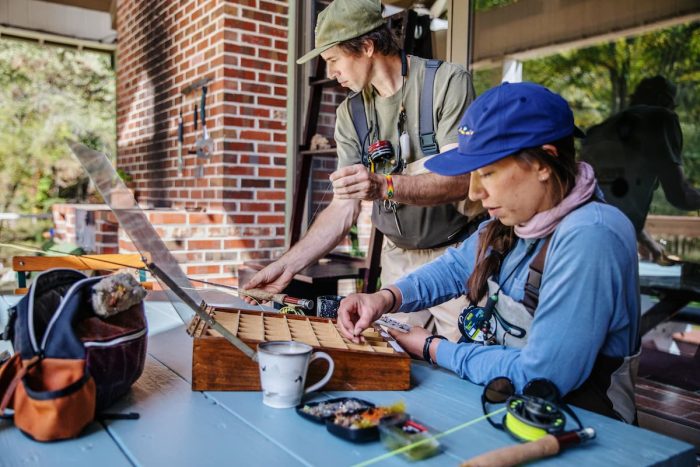Fly Fishing for Beginners in Nature’s Mountain Playground
My childhood introduction to fishing came from my father’s prompting. In many ways that first angling adventure with my dad solidified something deep within me that to this day shapes my outlook on hunting and fishing specifically, and for that matter, how I view life in general. To me it’s not about whether I bag a big buck or land a record largemouth; instead, it’s all about the experience. In truth, over the years I have taken at least one nice buck and managed to land more than a few respectable fish. And if you flip that coin over, I’ve also missed more strikes than I care to recall and allowed a wily buck or two to spot me before I spotted them. But that’s life; you can’t get them all. So for me, I choose to focus on the experience more than the outcome. I’ve learned that when I determine to enjoy the day — where I am, who I’m with, anything above and beyond that, well that’s just icing on the cake.
Getting back to that first fishing trip with my father, I honestly couldn’t tell you where we went (I was too small to see over the dashboard of his International Harvester truck) or if we even caught anything. But what I do remember, I’ll cherish for the rest of my life. It was a warm, sunny summer day and I was with my dad. We stood at the edge of an old farm pond, a battered and scarred tackle box on the ground between us, and I was with my dad. A lure was carefully tied to my line, I was patiently taught how to cast it out, into just the right spot, and I was with my dad. For me, it was all about the experience of being with him and the sense that he was passing something on to me that I would carry the rest of my life. It’s a memory I will forever cherish.
As I’ve gotten older, I’ve remained an angler, off and on, in one form or another. I’ve fished for rainbows in mountain streams, trolled for brown trout in Lake Michigan, and laughed out loud, landing bluegills with my kids. But for some reason, there has remained one style of fishing I’ve not yet tried — fly fishing. I think I’ve been saving that one for my golden years; mostly because I’ve always associated fly fishing as a skill set that comes only after years of devoted practice. I’ve also, for reasons that escape me, pictured fly fishing as the pursuit of comfortably retired, white-haired gentlemen — status in life I have yet to reach. But recently I’ve discovered just how incorrect that point of view has been. Fly fishing is practiced by young and old alike, men, women, and kids of all ages. I started to ask myself, “What the heck am I waiting for?” And since I’m not getting any younger, and because my home of Pocahontas County, West Virginia, has some of the best fly fishing streams in the state, I’ve begun a little research on the topic and have set upon the task to share some very basic knowledge of fly fishing with you. Think of it as an introductory course — Fly Fishing 101, if you will. So, let’s get started on fly fishing for beginners in Nature’s Mountain Playground.


Fly Fishing Versus Traditional Fishing
As with any introductory class, let’s begin with the basics and define our topic. Fly fishing differs quite dramatically from the traditional form of fishing most of us are probably familiar with. By traditional I mean a hook and bait of some kind are secured to a line and then cast out into a body of water; be that a stream, an ocean, or anything in between. The weight of the bait, sometimes along with added weight, is what makes it possible to cast the bait a significant distance. The bait or lure (and this depends on what type you use) is either allowed to float on top of the water, sink to the bottom, hang somewhere between the surface and the bottom, or be reeled back in towards the angler to mimic live bait. Granted this is an oversimplification of things, but it will suffice for our purposes.
Fly fishing, however, differs from this traditional method in almost every way. In fly fishing the angler uses specialized fly fishing gear; everything from the rod, reels, line and lures are designed solely with fly fishing in mind. In fly fishing, the angler tries to “present” the lure or “fly” in a way that mimics many of the tiny insects that trout and other fish feed on. Because the fly fisherman is attempting to use a lure that mimics an actual insect, the flies used must be little more than a decorated hook (imagine a single fishing hook in a fly costume and you get the idea). And it’s because of that single, tiny light-weight hook, that the traditional rod and reel must be replaced with specialized gear. A conventional bait casting pole with a monofilament line simply will not get the fly out far enough to be effective. This brings us to the subject of gear.
Fly Fishing Gear
Again, this may be a bit of an oversimplification of things but let’s stick to the basics. What does one need to fly fish? We can whittle the essentials down to four pieces of gear: a fly rod, a fly reel, fly line (which turns out to be a little more than you may think), and flies. As with most hobbies or pursuits, the essentials can range in cost from something very inexpensive to stuff that has you signing loan papers at the bank. Let common sense guide you here. Gear too cheap may break and need to be replaced which means you’ve spent more than you originally planned to spend, while expensive equipment may turn out to be a loss of money if you discover fly fishing isn’t for you. It’s usually best to start with gear somewhere in the middle of the price range.
Beginning with the fly rod, you’ll first need to give some thought to the conditions and areas you’ll most likely find yourself fishing. Fly rods come in different lengths and weights, and you’ll want to keep this in mind when selecting a rod. As a general rule of thumb, a nine-foot rod is better suited to fishing areas that tend to be windy. A rod of this length also works well for making longer casts, using a heavier line. Conversely, a shorter rod of eight feet or less is the go-to choice for most anglers fishing small streams that call for short, precise casting. Most beginners would be well served with an eight-and-a-half-foot rod, as it represents a reasonable compromise in length and will work well in a wide range of situations.


Fly reels are one of those areas where you definitely want to avoid the lower-end offerings. A plastic reel might be easy on the wallet, but it can quickly break and would require more money in the long run to replace. You’re better off spending a little more upfront for a quality, non-plastic reel that will perform better and last longer. And here’s a tip to remember. Because it’s a good idea that both rod and reel are matched (meaning the rod’s weight should be matched to the reel for the best overall performance of both), consider purchasing a rod and reel combination. Many online fly fishing stores feature these combos as an entry-level sales point for those getting started in fly fishing. By taking advantage of the manufacturer combining both rod and reel you’ll be assured they match and you’re likely to save a little money buying these items together.
Loading up that new fly rod and reel with line is nothing at all like what we did as kids with our traditional casting poles. That usually involved feeding the clear monofilament line through the eyes of the pole, tying it off on the spool of the reel, and cranking away on the reel until the spool was filled. Fly fishing line is actually comprised of four different parts: fly backing, fly line, tippet, and leader. Each of these four components of the fly line, in the order presented, flow from the reel to the fly and transition from a heavier, brightly colored line down to a thinner transparent line. As mentioned above, the fly itself does not provide enough weight to effectively cast it out at a suffocate distance. This is where weighted fly line comes into play. Without it, there’s no possibility to cast the tiny fly where an angler hopes to place it. The challenge then becomes one of how to “present” the fly on a weighted line that doesn’t slap the surface of the water and in turn frighten the fish away. Think of fly line as having a tapering shape from the heavier fly backing and fly line, down to the tippet which transitions from the thick fly line down to the thin, nearly invisible leader (which is similar to the clear monofilament line most of us are familiar with). The weighted line, therefore, makes casting possible, while the tapered tippet and leader make the presentation of the fly seem as if the angler’s fly is attached to nothing at all — just as if a delicious insect has lighted upon on the water’s surface, ringing a dinner bell for the hungry fish below. There’s really quite a bit of clever deception behind it all.
Well, the last piece of equipment that brings this all together is the fly. Let’s face it, without that little decorated hook; you’re just standing in a stream with a stick. Flies can be broken down into three primary types: dry flies, nymphs, and streamers. Dry flies are intended to look like flying insects that typically land and float on the surface of the water and are among the most common flies used by fly fishermen. Nymphs mimic aquatic food sources such as larvae and usually float on or just below the water’s surface. Larger than nymphs but similar in use, streamers are also intended to mimic aquatic food sources and are more akin to a traditional fishing lure. Not to throw a fly into the ointment (oh come on, you had to see that one coming) and to add to your list of options, you’ll have to decide whether you prefer your flies made with barbed or barbless hooks. A quick visit or call to your locale fly fishing shop should be able to help you narrow down the choices on which fly, and hook options are producing the best results.
Where to Go
Well now that you’ve got an idea of what fly fishing is and the basic gear needed, the next question is where to go? That’s where we at Nature’s Mountain Playground really shine. Pocahontas County is known for some of the best trout fishing in West Virginia. Nicknamed the Birthplace of Rivers, Pocahontas County contains the headwaters of eight rivers. Add to that the countless number of remote mountain streams within the Monongahela National Forest (1/3 of which lies within Pocahontas County) and two lakes; one within Watoga State Park and the other in Seneca State Forest, and you have plenty of wide-open space to hone your new fly fishing skills. And for those of you looking to combine fly fishing for trout with a little hiking adventure, be sure to check out fishing opportunities on the Williams River and the Cranberry Wilderness. Both areas offer some of the finest fly fishing within the state along with a rugged and solitary vibe that makes the art of fly fishing all that more enjoyable. When it comes to fly fishing for bass, trout, or even bluegill, Pocahontas County offers the best in the state of West Virginia. So, grab that new fly rod and start making some memories in Nature’s Mountain Playground.
